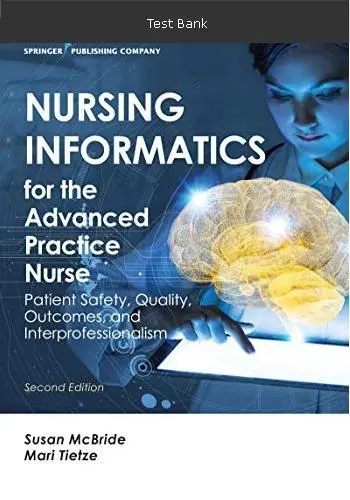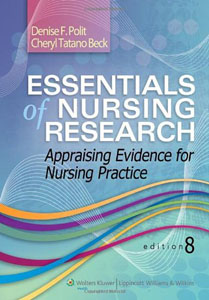In Stock
Nursing Informatics for the Advanced Practice Nurse 2nd Ed. Test Bank
$55.00 Original price was: $55.00.$23.00Current price is: $23.00.
Digital item No Waiting Time Instant Download
Chapters: 30
Format: PDF
ISBN-13: 978-0826140456
ISBN-10: 0826140459
Publisher: LWW
Authors: FAAN McBride, Susan, FAAN Tietze, & Mari
SKU: 000786000581
Category: NURSING
Description
Nursing Informatics for the Advanced Practice Nurse 2nd Ed. Test Bank
Section I. Introduction
Chapter 1. Introduction to Health Information Technology in a Policy and Regulatory Environment
Chapter 2. Advanced Practice Roles in Interprofessional Teams
Chapter 3. Scientific and Theoretical Foundations for Driving Improvement
Chapter 4. National Healthcare Transformation and Information Technology
Chapter 5. Consumer Engagement/Activation Enhanced by Technology
Section II. Point-of-Care Technology
Chapter 6. Computers in Healthcare
Chapter 7. Electronic Health Records and Point-of-Care Technology
Chapter 8. Systems Development Life Cycle for Achieving Meaningful Use
Chapter 9. Workflow Redesign in a Quality-Improvement Modality
Chapter 10. Evaluation Methods and Strategies for Electronic Health Records
Chapter 11. Electronic Health Records and Health Information Exchanges Providing Value and Results for Patients, Providers, and Healthcare Systems
Chapter 12. National Standards for Health Information Technology
Chapter 13. Public Health Data to Support Healthy Communities in Health Assessment Planning
Chapter 14. Privacy and Security in a Ubiquitous Health Information Technology World
Chapter 15. Personal Health Records and Patient Portals
Chapter 16. Telehealth and Mobile Health
Section III. Data Management
Chapter 17. Strategic Thinking in Design and Deployment of Enterprise Data, Reporting, and Analytics
Chapter 18. Data Management and Analytics: The Foundations for Improvement
Chapter 19. Clinical Decision Support Systems
Chapter Section IV. Patient Safety/Quality and Population Health
Chapter 20. Health Information Technology and Implications for Patient Safety
Chapter 21. Quality-Improvement Strategies and Essential Tools
Chapter 22. National Prevention Strategy, Population Health, and Health Information Technology
Chapter 23. Electronic Clinical Quality Measures: Building an Infrastructure for Success
Chapter 24. Developing Competencies in Nursing for an Electronic Age of Healthcare
Section V. New and Emerging Technologies
Chapter 25. Genomics and Implications for Health Information Technology
Chapter 26. Nanotechnology, Nanorobotics, and Implications for Healthcare Interprofessional Teams
Chapter 27. “Big Data” and Advanced Analytics
Chapter 28. Social Media: Ongoing Evolution in Healthcare Delivery
Chapter 29. Enhancing Cybersecurity in New and Emerging Health Informatics Environments
Chapter 30. Interprofessional Application of Health Information Technology in Education
Nursing Informatics for the Advanced Practice Nurse 2nd Edition McBride Tietze Test Bank
Chapter 1. Introduction to Health Information Technology in a Policy and Regulatory
Environment
Chapter 1
1. After teaching a class about informatics, the instructor determines that the teaching was
successful when the students define informatics as which of the following?
A) Use of computers
B) Use of information technology
C) Management of information
D) Access to the Internet
2. A strategic plan for the nationwide implementation of health information technology
includes which of the following?
A) Discouraging the use of personal electronic health records
B) Developing a collaborative governance to support information use for population
health
C) Advocating for statewide adoption of electronic health record
D) Limiting the use of telehealth systems
3. Which of the following would a nurse identify as the current focus of today’s practice
informatics?
A) Capturing data at the point of care
B) Performing secondary data analysis
C) Using aggregated data
D) Making decisions based on data
4. A nursing student is reviewing information about early computerized clinical
information systems. Which of the following would the student identify as
characteristic?
A) Implementation to perform two or three functions
B) Ability to share information among several departments
C) Creation of different software systems for different areas
D) Entry of data occurring only once
5. When describing the benefits of informatics to a group of agency staff, which of the
following would the presenter identify as one of the primary benefits?
A) Increase usability of data
B) Promote cost-saving
C) Promote time-saving
Environment
Chapter 1
1. After teaching a class about informatics, the instructor determines that the teaching was
successful when the students define informatics as which of the following?
A) Use of computers
B) Use of information technology
C) Management of information
D) Access to the Internet
2. A strategic plan for the nationwide implementation of health information technology
includes which of the following?
A) Discouraging the use of personal electronic health records
B) Developing a collaborative governance to support information use for population
health
C) Advocating for statewide adoption of electronic health record
D) Limiting the use of telehealth systems
3. Which of the following would a nurse identify as the current focus of today’s practice
informatics?
A) Capturing data at the point of care
B) Performing secondary data analysis
C) Using aggregated data
D) Making decisions based on data
4. A nursing student is reviewing information about early computerized clinical
information systems. Which of the following would the student identify as
characteristic?
A) Implementation to perform two or three functions
B) Ability to share information among several departments
C) Creation of different software systems for different areas
D) Entry of data occurring only once
5. When describing the benefits of informatics to a group of agency staff, which of the
following would the presenter identify as one of the primary benefits?
A) Increase usability of data
B) Promote cost-saving
C) Promote time-saving
C) Promote time-saving
D) Allow identification of patterns
6. After teaching a group of students about the benefits of informatics to the
nursing profession, the instructor determines that the students need additional
teaching when they identify which of the following as a benefit?
A) Improvement in documentation
B) Use of data for quality control
C) Building of evidence-based knowledge
D) Increase in time needed for documentation
7. A nurse is presenting an in-service program on nursing informatics competencies.
When describing the need for computer fluency for nursing informatics competencies,
which of the following would the presenter include as characterizing this concept?
A) Temporary state
B) Lifelong learning
C) Task oriented
D) Competency
8. After teaching a class for a group of nurses on nursing informatics, the instructor
determines that the teaching was successful when the group identifies which of the
following competencies as specific to the role of an informatics innovator?
A) Using basic desktop software
B) Generating informatics theory
C) Making judgments about trends
D) Communicating via a computer
9. An informatics nurse specialist would describe information literacy as essential for
which of the following?
A) Critical thinking
B) Problem solving
C) Data evaluation
D) Evidence-based practice
10. When preparing for a class on healthcare informatics and information technology, the
instructor would emphasize which of the following as the focus?
A) Information
B) Computer
C) Access
D) Data storage
11. When describing the components needed to provide evidence-based care
through informatics, which of the following would be needed? Select all that
D) Allow identification of patterns
6. After teaching a group of students about the benefits of informatics to the
nursing profession, the instructor determines that the students need additional
teaching when they identify which of the following as a benefit?
A) Improvement in documentation
B) Use of data for quality control
C) Building of evidence-based knowledge
D) Increase in time needed for documentation
7. A nurse is presenting an in-service program on nursing informatics competencies.
When describing the need for computer fluency for nursing informatics competencies,
which of the following would the presenter include as characterizing this concept?
A) Temporary state
B) Lifelong learning
C) Task oriented
D) Competency
8. After teaching a class for a group of nurses on nursing informatics, the instructor
determines that the teaching was successful when the group identifies which of the
following competencies as specific to the role of an informatics innovator?
A) Using basic desktop software
B) Generating informatics theory
C) Making judgments about trends
D) Communicating via a computer
9. An informatics nurse specialist would describe information literacy as essential for
which of the following?
A) Critical thinking
B) Problem solving
C) Data evaluation
D) Evidence-based practice
10. When preparing for a class on healthcare informatics and information technology, the
instructor would emphasize which of the following as the focus?
A) Information
B) Computer
C) Access
D) Data storage
11. When describing the components needed to provide evidence-based care
through informatics, which of the following would be needed? Select all that
apply.
A) Information presented in a digital format
B) Standards for exchange of information
C) Limited ability to capture relevant data
D) Multiple language structures for documentation
E) Competency of practitioners using the information
12. A nurse is reviewing an article about the strategic plan for health information
technology as related to population health. Which of the following would the nurse
expect to find as being supported by this goal? Select all that apply.
A) Biomedical research
B) Cost-efficient patient care
C) Public health
D) Quality improvement
E) Emergency preparedness
13. A nurse is preparing an in-service program about forces driving toward the increased
use of informatics in healthcare. Which of the following would the nurse include as a
national force? Select all that apply.
A) Creation of the President’s Information Technology Advisory Committee (PITAC)
B) The Institute of Medicine (IOM) report on Health Professions Education
C) National Advisory Council on Nurse Education and Practice recommendations
D) National League for Nursing (NLN) position paper on nurse preparation
E) Technology Informatics Guiding Educational Reform (TIGER) initiative
14. A nurse working in informatics is analyzing information gathered about rates of
infection of patients on a specific hospital unit. The nurse is using this information to
determine appropriate interventions for overall infection control. The nurse is involved
with which of the following?
A) Point of care informatics
B) Secondary data analysis
C) Listserv
D) Computerized provider order entry
15. A nurse involved in informatics identifies the need for information and
demonstrates ability to locate, evaluate, and effectively use it. The nurse is
demonstrating which of the following?
A) Information literacy
B) Computer literacy
C) Computer fluency
D) Information management
Answer Key
1. B
A) Information presented in a digital format
B) Standards for exchange of information
C) Limited ability to capture relevant data
D) Multiple language structures for documentation
E) Competency of practitioners using the information
12. A nurse is reviewing an article about the strategic plan for health information
technology as related to population health. Which of the following would the nurse
expect to find as being supported by this goal? Select all that apply.
A) Biomedical research
B) Cost-efficient patient care
C) Public health
D) Quality improvement
E) Emergency preparedness
13. A nurse is preparing an in-service program about forces driving toward the increased
use of informatics in healthcare. Which of the following would the nurse include as a
national force? Select all that apply.
A) Creation of the President’s Information Technology Advisory Committee (PITAC)
B) The Institute of Medicine (IOM) report on Health Professions Education
C) National Advisory Council on Nurse Education and Practice recommendations
D) National League for Nursing (NLN) position paper on nurse preparation
E) Technology Informatics Guiding Educational Reform (TIGER) initiative
14. A nurse working in informatics is analyzing information gathered about rates of
infection of patients on a specific hospital unit. The nurse is using this information to
determine appropriate interventions for overall infection control. The nurse is involved
with which of the following?
A) Point of care informatics
B) Secondary data analysis
C) Listserv
D) Computerized provider order entry
15. A nurse involved in informatics identifies the need for information and
demonstrates ability to locate, evaluate, and effectively use it. The nurse is
demonstrating which of the following?
A) Information literacy
B) Computer literacy
C) Computer fluency
D) Information management
Answer Key
1. B





Be the first to review “Nursing Informatics for the Advanced Practice Nurse 2nd Ed. Test Bank”